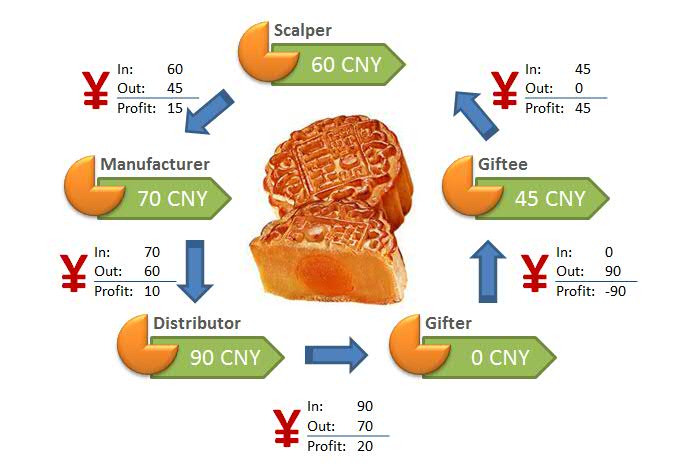So I just had a nice little three day weekend thanks to this little holiday called the Mid-Autumn Festival. The official date falls on August 15 of the lunar calendar year, and while its origins are still debatable, the tradition is to gather with your family, gaze at the bright full moon, and of course, eat delicious moon cakes.
The tradition of moon cakes began during the Tang dynasty. While they were first introduced in the imperial courts, their popularity soon spread among the public. Their circular shape (“yuan”), which in Chinese is part of the word “tuanyuan”, or reunite, elevated the delicacy to the symbol of family reunification. Today, family members and friends give moon cakes as gifts to each other on Mid-Autumn Day, and the tradition has become a popular relation building gesture in the corporate world as well.
As the holiday rolled closer, I couldn’t help but notice the increase in people holding wads of hundred yuan bills standing in front of my subway station. I had no idea what they were up to at first, until the day I complained to a coworker about the ridiculous price of moon cakes at Starbucks. I had planned to get some moon cakes for the nice security guards in my building who always receive my packages, and Starbucks seemed as good a place as any to buy them. Except when I looked at the price, a box of 10 moon cakes was 598 yuan, or about $100 USD. I thought it was quite ridiculous to spend $10 on a tiny piece of pastry (especially considering I get a full and fulfilling breakfast for about $2 every morning), and vented to a coworker accordingly. He then gave me some tips and introduced me to the interesting economics of “moon cake coupons,” which was so fascinating that I had to share.
Moon cake coupons are, as the name indicates, coupons you can use to exchange for moon cakes at certain stores. The moon cake manufacturers print these out and sell them to distributors at a discount price. Distributors then sell these to either consumers or companies for a slightly higher price, and these consumers/companies (let’s call them gifters) will usually gift them to friends, employees, or clients. Logic follows that these coupons will then be traded for the actual product — the moon cakes, however, this is where it gets interesting! Many of the people who receive the coupons, let’s call them giftees, don’t actually want the moon cakes. So instead, they either sell them to scalpers (remember the people with money standing outside of the subway stations?) or to other people who might need them through online exchange sites. Who do you think the scalpers sell the coupons to? Well, some are sold to people who need them, but here’s the real kicker — most of these coupons are sold back to the moon cake manufacturers, at another discount, thus ending the transaction cycle. Do you notice anything missing from this complicated exchange?
THE MOON CAKES!!
OK, so I may have been the only one mind blown about this whole thing, but I find this to be truly fascinating. And because I’m such a nerd, I even made a flow chart to illustrate this: As you can see, the gifter was the only person who actually paid for the coupons, and all the other parties made some kind of profit off of it. Throughout this whole process, no moon cake was actually made! Pretty ingenious if you ask me.
As you can see, the gifter was the only person who actually paid for the coupons, and all the other parties made some kind of profit off of it. Throughout this whole process, no moon cake was actually made! Pretty ingenious if you ask me.
This is only a small part of the whole moon cake economy (plenty of moon cakes are still bought, sold, and eaten, and plenty of coupons are used for that purpose) and of course, an even smaller part of the whole economy, but the fact that such a robust and complex grey economy emerged so quickly based on one product sold for one occasion every year is quite amazing. And now that Mid-Autumn Day has passed, I’m finally able to get some cheap and delicious moon cakes for myself 🙂
(Pardon the interruption, regular travel blogging will resume shortly :P)

Leave a Reply